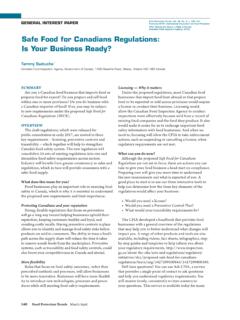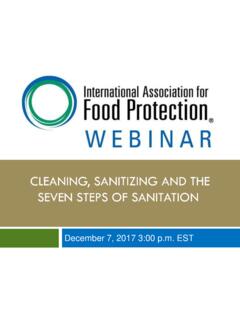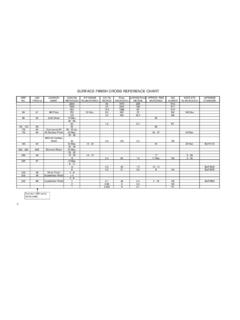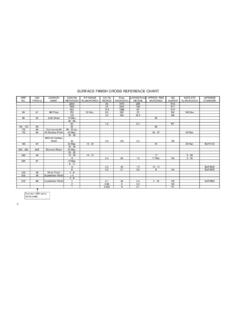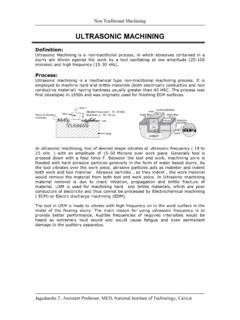Transcription of Characteristics of Food Contact surface materials ...
1 Food Protection Trends, Vol. 32, No. 10, Pages 574 584. Copyright 2012, International Association for Food Protection 6200 Aurora Ave., Suite 200W, Des Moines, IA 50322-2864. Characteristics of Food Contact surface materials : Stainless Steel Ronald H. Schmidt,1* Daniel J. Erickson,2 Steven Sims3 and Philip Wolff4. 1. Food Science and Human Nutrition Dept., University of Florida, 110370, Gainesville, FL 32611, USA;. 2. Harold Wainness and Associates, 2460 1st Ave. East, North St. Paul, MN 55109, USA; Dept. of Health and Human Services, Food and Drug Administration, Office of Food Safety, Center for Food Safety and Applied Nutrition, 5100 Paint Branch Pkwy., College Park, MD 20740-3835, USA; Dept.
2 Of Agriculture, Agricultural Marketing Service, Dairy Grading Branch, 1400 Independence Ave., SW, Washington, 20250-2030, USA. summary This technical review article describes the properties and Characteristics of stainless steel in sanitary design when used as a food Contact surface , particularly when compliance with the requirements of standards promulgated by 3-A Sanitary Standards, Inc. is intended. It discusses the general Characteristics of stainless steels, including ferrite, austenite, cementite, and martensite. It discusses stainless steel categories and grades used in industrial applications and their properties, including both non-magnetic types such as superaustenitic and magnetic types such as ferric and martenistic as well as duplex stainless steel and precipitation hardened stainless steel.
3 Specific emphasis is given to those categories and grades used in food Contact applications. The article contains a discussion on the general steps in stainless steel manufacturing, including melting/casting, forming, heat treatment/annealing, descaling, cutting, and finishing, and describes common types of acceptable surface modification and finishing of stainless steel. In addition to the topics listed above, the article describes common types and causes of corrosion of stainless steel, including uniform, pitting, crevice, stress cracking, galvanic, Contact , and biologically and microbiologically influenced corrosion. Finally the article discusses methods of preventing corrosion, including surface maintenance and cleaning and a process referred to as passivation.
4 This article contains micrographs showing, at varying levels of magnification, chemical corrosion and some common surface finishes, including number 4 (150 grit), 2B, and 2D finishes, as well as photographs showing unacceptable product Contact surface finishes of welds in stainless steel tubing. A peer-reviewed article *Author for correspondence: Phone: +1 ; Fax: +1 E-mail: 574 FOOD PROTECTION TRENDS | OCTOBER 2012. INTRODUCTION sitional distribution and chemical com- While there is considerable variation binations of iron and carbon. For exam- with regard to properties within each of From a sanitary design perspective, ple, ferrite (predominately - iron and the stainless steel categories, their general food Contact surfaces should be smooth, - iron) is relatively soft, while austenite properties are summarized in Table 1.
5 Impervious, free of cracks and crev- (predominately - iron) is much harder, The general classes of stainless steel ices, non-porous, non-absorbent, non- and cementite (predominately Fe3C) is alloys can be further subdivided accord- contaminating, non-reactive, corrosion extremely hard. Martensite has inter- ing to composition, common AISI grade, resistant, durable, and cleanable (24). mediate Fe-C levels and mixed chemical crystal structure, specific properties, and Further, materials used in food Contact species and forms. In general, the crys- applications. A comparison of proper- surfaces must be non-toxic, and materi- talline structure of ferrite, austenite, and ties, Characteristics , and applications of als containing heavy metals ( , lead, martesite is usually body-centered cubic, selected stainless steel grades is presented cadmium, hexivalent chromium or mer- face-centered cubic and needle-like, re- in Table 2, and the chemical alloy com- cury) or other toxic materials must be spectively.
6 Position of selected stainless steel grades avoided. Finally, these surfaces should be Stainless steel, in general, is an is presented in Table 3. fabricated, operated, and maintained in Fe-C alloy with additional alloying ele- The most common stainless steels a manner such that these criteria are not ments. These alloying elements may used in food processing and handling compromised. Stainless steel is generally include copper (Cu), chromium (Cr), equipment are made from Fe-C-Cr alloys the most preferred and most commonly molybdenum (Mo), manganese (Mn), and Fe-C-Cr-Ni alloys, with other alloy- used material in the design, construction nickel (Ni), nitrogen (N), phosphorus ing elements used to varying degrees.
7 Cr, and fabrication of food processing equip- (P), silicon (Si), sulfur (S), selenium (Se), upon exposure to air, gives stainless steel ment and is specified in the 3-A Sanitary tungsten (Tn), and titanium (Ti). its characteristic high resistance to stain . Standards (1) as well as in other com- Base stainless steels are generally (or corrosion) by forming a thin passive . monly used food processing equipment formulated from iron (minimum of 50% layer of chromium (III) oxide (Cr2O3), standards throughout the world (20). by weight), carbon and chromium (min- iron oxide, and other oxides. The passive The general advantages of stainless imum by weight), and their prop- layer protects the active material (iron), steel over other materials for food con- erties are dependant upon the relative which is susceptible to rust and corro- tact are as follows: concentrations of these elements.
8 Prop- sion. Nickel (when present) provides corrosion resistance (ranging erties of additional alloying elements will additional corrosion resistance as well from fair to outstanding); be discussed. as greater strength and structural hard- high strength, high hardness, ness to stainless steel. However, as will high modulus; Stainless steel categories be discussed, Ni-based stainless steels are availability of a wide range of and grades, and their properties more susceptible to one type of corro- product forms; sion, termed Stress Corrosion Cracking relative ease of machining and More than 150 grades or types of (SCC), than are those without Ni. fabrication; and stainless steel exist.
9 The traditional no- In general, alloys formulated at relatively low cost. menclature to define stainless steel grades higher carbon levels are of greater struc- is the numbering system of the American tural hardness and strength than those A wide variety of stainless steel Iron and Steel Institute (AISI), a func- formulated at lower carbon levels. Addi- materials are available with widely tion now under the American Society of tional carbon also provides resistance to varying composition, surface finish, and Testing and materials (ASTM) (2). The oxidation and creep. However, the risk functional properties (2, 4, 5, 6, 7, 8, 23). traditional AISI Stainless Steel Products of corrosion may be increased with high- In addition, the functionality of stainless Manual, currently published by the Iron carbon stainless steel materials .
10 Steel is impacted by surface treatments and Steel Society (14), provides a listing In higher grade stainless steels, Mo and coatings. Thus, an awareness of the of stainless steel grades, composition, and/or N (and to a lesser extent Cu) are properties of the various stainless steels and properties. While AISI grading sys- added to enhance the passivation layer is required by fabricators, as well as by tem has traditionally used a three-digit through forming oxides of these ele- potential users of food equipment. numbering system, newer grades allocate ments, thus providing additional corro- General Characteristics 1-letter + 5 digit UNS numbers. While sion resistance. Mo (which forms molyb- of stainless steel the AISI grade designations define the denum oxide in the passivation layer) is individual grades, they are not specifi- especially effective at preventing the type From a metallurgical perspective, cations as such.

